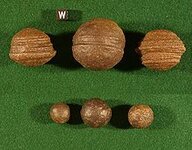turtlefoot13
Hero Member
- Aug 23, 2009
- 733
- 105
- Detector(s) used
- Teknetics Alpha 2000
- Primary Interest:
- Relic Hunting
I had part of my property bulldozed for landscaping reasons and was walking the freshly opened ground and found this rock. If it wasn't broken, it would be a sphere. I have seen a lot of strange rocks in the past but nothing like this one. The mark close to the top in the first pic looks like some sort of rock boring beetle got to it.  Any ideas will be helpful. While walking the open ground I also found pieces of very old blue glass and pieces of a stoneware type of crock/jug. The hematite that I found a couple of weeks ago was found about 1/4 of a mile from where this rock was found, if that has any bearing. Arrow heads have been found within two hundred yards of where this rock was found plus I have found a couple of fossils in a seasonal creek bed less than one hundred yards of where this rock was found (I am leaving all possibilities open for the time being).
Any ideas will be helpful. While walking the open ground I also found pieces of very old blue glass and pieces of a stoneware type of crock/jug. The hematite that I found a couple of weeks ago was found about 1/4 of a mile from where this rock was found, if that has any bearing. Arrow heads have been found within two hundred yards of where this rock was found plus I have found a couple of fossils in a seasonal creek bed less than one hundred yards of where this rock was found (I am leaving all possibilities open for the time being).
Thanks,
Doug



 Any ideas will be helpful. While walking the open ground I also found pieces of very old blue glass and pieces of a stoneware type of crock/jug. The hematite that I found a couple of weeks ago was found about 1/4 of a mile from where this rock was found, if that has any bearing. Arrow heads have been found within two hundred yards of where this rock was found plus I have found a couple of fossils in a seasonal creek bed less than one hundred yards of where this rock was found (I am leaving all possibilities open for the time being).
Any ideas will be helpful. While walking the open ground I also found pieces of very old blue glass and pieces of a stoneware type of crock/jug. The hematite that I found a couple of weeks ago was found about 1/4 of a mile from where this rock was found, if that has any bearing. Arrow heads have been found within two hundred yards of where this rock was found plus I have found a couple of fossils in a seasonal creek bed less than one hundred yards of where this rock was found (I am leaving all possibilities open for the time being).Thanks,
Doug







